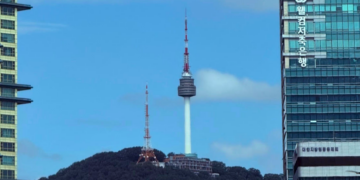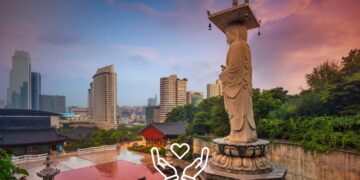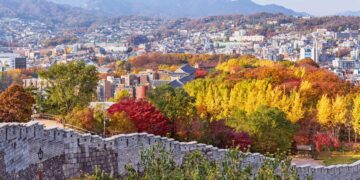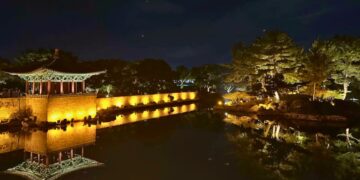Last Updated on 2 years by admin
Fall in South Korea is a spectacle of nature’s grandeur, painting the landscapes in vibrant hues of red, orange, and gold. As the country’s majestic mountains, serene national parks, and bustling cities don the autumnal cloak, they offer a visual feast for locals and tourists.
From the early foliage of Seoraksan to the iconic fall vistas of Naejangsan, this guide takes you through South Korea’s premier autumn destinations. Discover the unique charm of each location the peak dates to witness the best of the fall colors, and immerse yourself in the poetic beauty of Korea’s autumn season.
Where to Enjoy Fall Foliage in South Korea
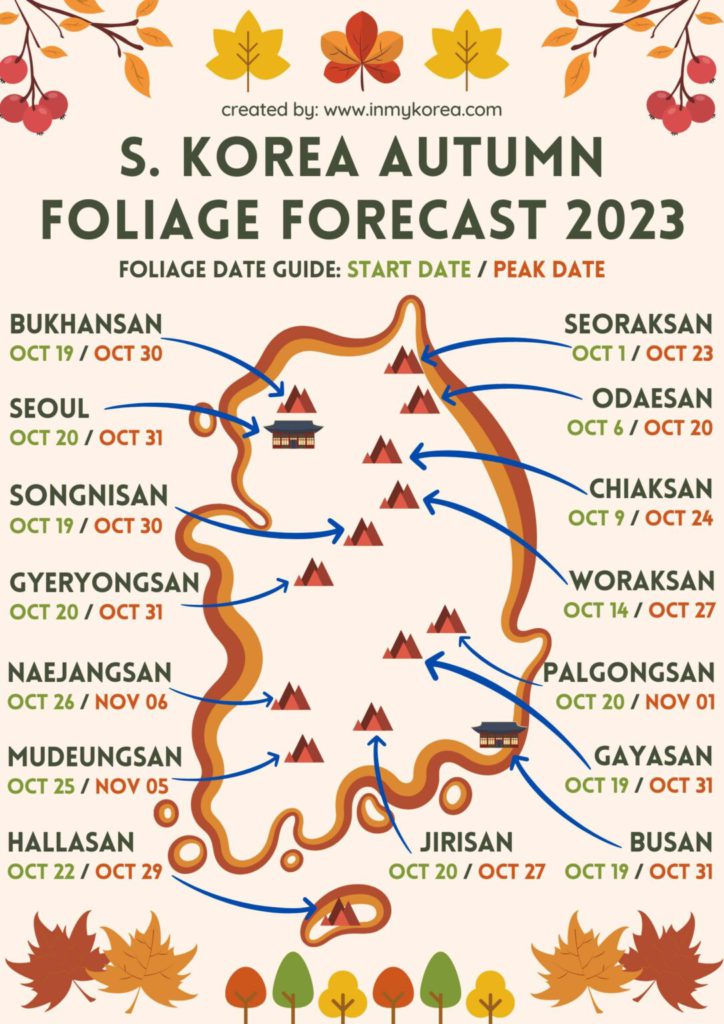
Seoraksan
Start date: October 1
Peak date: October 23
Seoraksan, or Mount Seorak, renowned for its early foliage, witnessed its first fall leaves on September 30. With the fall season gradually shortening, planning your visit wisely is crucial to avoid the bustling crowds.
There are two trees that are perfect for seeing fall leaves in Korea: maple and ginkgo. The Asan Gingko Tree Road specializes in the latter and is the best place to see this gorgeous golden cascade of colors. Imagine strolling down the beautiful, tree-lined streets of Asan Gingko Tree Road, with a carpet of golden leaves below and lemony clouds above. Gingko trees are famous for their many leaves that slowly drop their leaves, waiting for you to tread on them.
Odaesan
Start date: October 6
Peak date: October 20
Odaesan in fall is a breathtaking spectacle, a masterpiece painted by nature herself. As the season descends upon the mountainous terrains, the dense forests of Odaesan come alive with a vibrant tapestry of reds, oranges, and yellows. The serene beauty of the mountain is amplified by the gentle rustling of leaves and the crisp, cool air that carries the scent of earth and foliage.
Hikers and nature enthusiasts flock to Odaesan during this time, captivated by its mystical charm and the fleeting beauty of fall. It’s a season of reflection, of appreciating the transient nature of life, and Odaesan provides the perfect backdrop for such contemplation.
Chiaksan
Start date: Oct 9
Peak date: Oct 24
Chiaksan, with its rugged peaks and scenic beauty, undergoes a captivating transformation during the fall months. The forested trails come alive with a vibrant tapestry of reds, oranges, and yellows as the trees shed their summer greens. As hikers go through the twisting paths, the crisp fall air is filled with the rustling of fallen leaves underfoot. Overhead, the azure sky contrasts sharply with the fiery foliage, creating a picturesque setting that draws both locals and tourists alike.
Woraksan
Start date: Oct 14
Peak date: Oct 27
In the heart of South Korea, Woraksan National Park welcomes the embrace of the fall season with a serene elegance. As the season progresses, the expansive forests of Woraksan are painted with a medley of amber, gold, and scarlet hues, each tree telling its own story of the passage of time. The mountain streams, flowing with a renewed vigor after the summer rains, reflect the kaleidoscope of colors from the overhead canopy. Birds sing their pre-winter melodies, providing a gentle soundtrack to the hushed whispers of falling leaves. For those who venture to Woraksan during this season, the blend of nature’s tranquility and its dramatic fallal display offers an unforgettable retreat.
Bukhansan
Start date: Oct 19
Peak date: Oct 30
Bukhansan, located near the bustling metropolis of Seoul, is a testament to nature’s ability to coexist with urban sprawl. Come fall, this beloved national park becomes a mosaic of vibrant colors. The granite peaks, usually stark and imposing, are softened by the russet, gold, and crimson patchwork that cloaks the slopes. As the temperature drops, the cool, brisk air carries with it the earthy scent of decaying leaves, reminding visitors of the cyclical beauty of nature. Many Seoulites, eager to escape the city’s pace, find solace in Bukhansan’s trails during this season. Overlooking the city, the mountain stands as a beacon of natural beauty amidst the urban landscape, especially radiant during the fall.
Gayasan
Start date: Oct 19
Peak date: Oct 31
Gayasan National Park, nestled in southern South Korea, is a spectacle of natural splendor, especially during the fall. As fall unfurls its tapestry, the slopes of Gayasan are adorned with a vibrant palette of ochres, siennas, and ruby reds.
The famed Haeinsa Temple, located within the park, adds a touch of historical and cultural depth to the landscape, its ancient wooden structures harmoniously blending with the fallal hues.
Pilgrims and tourists alike, wrapped in the embrace of the cool air, find a sense of tranquility as they traverse the pathways, where the sounds of chanting monks often meld with the gentle rustle of leaves. Gayasan, in its fallal glory, is a confluence of natural beauty and spiritual serenity.
Busan
Start date: Oct 19
Peak date: Oct 31
Busan, South Korea’s coastal city, undergoes a subtle yet enchanting transformation during fall. While best known for its bustling ports, sandy beaches, and shimmering blue seas, the city takes on a different charm as summer transitions to fall. The trees that line the city streets and parks erupt in shades of gold, crimson, and amber, casting dappled shadows on the pavements.
The cool fall breezes from the ocean carry a hint of salt, mingling with the sweet scent of falling leaves. As the days grow shorter, the city’s vibrant nightlife, from the bustling night markets to the lively festivals, lights up against the backdrop of the early twilight. In Busan, fall blends urban excitement and nature’s calm, where the changing leaves meet the timeless tides.
Songnisan
Start date: October 19
Peak date: October 30
Songnisan National Park, located in the heart of South Korea, is a haven of natural beauty and serenity, and in the fall, it takes on an ethereal charm. The vast expanses of dense forests that blanket the mountain ranges of Songnisan burst into a riot of reds, oranges, and yellows, creating a visually stunning panorama. The towering granite peaks seem to stand guard over the kaleidoscope below, their majesty amplified by the fallal display.
The iconic Beopjusa Temple, with its ancient pagodas and statues, is framed by fiery foliage, offering a perfect blend of nature’s artistry and human craftsmanship. Hikers and pilgrims, as they tread along the trails, are enveloped in the crisp air, accompanied by the soft crunch of leaves underfoot. Fall in Songnisan is a symphony of colors, sounds, and sensations, evoking a deep sense of awe and reverence.
Jirisan
Start date: Oct 20
Peak date: Oct 27
Jirisan, one of South Korea’s most revered mountain ranges, wears fall like a majestic cloak. Spanning three provinces, the vast landscapes of Jirisan National Park transition into an artist’s canvas come fall. Once green, expansive meadows take on gold and amber hues, while dense woodlands explode in a fiery display of crimsons, oranges, and yellows.
As the highest peak in the southern part of the peninsula, Jirisan offers panoramic views that are exceptionally breathtaking during this season. The valleys echo with the sounds of gushing streams and rivers, their waters reflecting the brilliant foliage above. Traditional temples and hermitages, tucked away in its nooks and crannies, exude a mystical aura when framed by vibrant colors. For trekkers, nature enthusiasts, and those seeking spiritual solace, Jirisan in fall is a journey of beauty, introspection, and awe.
Seoul
Start date: October 20
Peak date: October 31
Seoul, the pulsating capital of South Korea, transforms into a city of poetic beauty during fall. Beyond its modern skyscrapers and bustling streets, pockets of tranquility emerge as trees drape themselves in vibrant shades of red, orange, and gold. The Han River, which slices through the city, reflects the changing colors of the season, offering a picturesque juxtaposition of nature and urbanity.
Royal Palaces: A Cultural and Visual Feast
Adorned with fall colors, Korea’s royal palaces host the “2023 Fall K-Royal Culture Festival” from October 13 to 18, offering various cultural events and performances.
Gyeongbok Palace: Pansori Performances
Dates: October 13-14 and 17-18
Reservations: Required for guaranteed seating
Gyeongbok Palace will host traditional pansori performances and other musical acts, narrating the palace’s restoration story and celebrating Korean music.
Changgyeong Palace: Exhibitions and Lectures
Dates: October 13-18 (exhibition) and 16-17 (lectures)
Changgyeong Palace will feature a photo exhibition and lectures exploring the palace’s history and the efforts to restore its Korean name, Changgyeonggung.
For festival program reservations and additional information, visit the Royal Palaces and Tombs Center website (royal.cha.go.kr) or call 1522-2295.
Gyeryongsan
Start date: Oct 20
Peak date: Oct 31
Gyeryongsan, located in central South Korea, is a testament to nature’s timeless beauty, particularly during the fall season. With its rich biodiversity and spiritual significance, this revered mountain range becomes a spectacle of colors as fall sets in. The dense woodlands, home to many plant species, change into a dazzling display of crimsons, golds, and deep purples.
Ancient temples and hermitages, like Donghaksa and Sinwonsa, are nestled amidst the vibrant foliage, creating a serene ambiance that attracts both devout pilgrims and nature enthusiasts. The harmonious melodies of chanting monks resonate through the forests, blending with the whispering winds and rustling leaves. Trails crisscrossing Gyeryongsan are frequented by hikers eager to witness the season’s splendor from various vantage points.
Palgongsan
Start date: Oct 20
Peak date: Nov 01
Palgongsan, situated in the southeastern region of South Korea, is a blend of natural splendor and cultural heritage, especially radiant in the embrace of fall. As the season unfolds, the mountain’s verdant forests transition to a mesmerizing spectrum of golds, ambers, and deep reds.
This rich tapestry of colors provides a stunning backdrop to the many temples and statues dotting the landscape, including the famous Gatbawi Buddha, which seems to meditate peacefully amidst the fall foliage. Streams cascading down the slopes reflect the vibrant canopy overhead, creating mirror-like pools of fallal hues. Hikers and visitors, while navigating the winding trails, are treated to crisp, cool air and the gentle symphony of rustling leaves and chirping birds. Palgongsan, during this season, offers an enriching experience, a harmonious blend of nature’s beauty and the region’s rich spiritual legacy.
Hallasan
Start date: October 22
Peak date: October 29
Hallasan, the iconic shield volcano that dominates South Korea’s Jeju Island, is a marvel of natural beauty and diversity, especially during fall. The mountain, the highest peak in South Korea, boasts unique ecosystems that undergo a breathtaking transformation as the season changes. Hallasan’s slopes are adorned with a vivid array of fallal hues from its base to its summit, ranging from deep crimsons to brilliant golds.
The walking paths, such as the Seongpanak and Gwaneumsa trails, offer hikers panoramic vistas of the colorful tapestry interspersed with volcanic craters and serene lakes. Amidst the vibrant foliage, the occasional sighting of the island’s endemic deer, the Jeju roe deer, adds to the enchantment. As the calm winds sweep the mountain, they carry the fragrant scent of fallen leaves and the distant sounds of the surrounding ocean, encapsulating the essence of Jeju’s fall in Hallasan’s majestic embrace.
Mudeungsan
Start date: Oct 25
Peak date: Nov 05
Mudeungsan, nestled in the southwestern region of South Korea near Gwangju, stands as an emblem of age-old serenity and scenic beauty, which becomes particularly pronounced in the fall. The mountain’s unique rock formations, known as the “Jusangjeolli cliffs,” provide a stark, sculpted contrast to the burst of fiery reds, warm oranges, and golden yellows that the trees proudly wear during this season. As one ascends the trails, the view juxtaposes these ancient rocks against a canvas of fallal colors, creating a surreal and picturesque landscape. The crisp air is punctuated with crunching leaves underfoot, while the temples scattered across Mudeungsan, like Jeungsimsa, offer peaceful retreats where nature’s fall display enhances the spiritual atmosphere. Whether for hiking, reflection or simply soaking in the beauty, Mudeungsan in the fall is a testament to nature’s artistry and timeless charm.
Naejangsan
Start date: Oct 26
Peak date: Nov 06
Literally meaning ‘concealed inside,’ Naejangsan has a treasure trove of hidden wonders that offer awe-inspiring photo opportunities, beautiful backgrounds, and the chance to find spiritual calm among natural beauty. Late October and early-November are the best times to visit Naejangsan as the fall leaves turn fiery red and golden yellow. Truly one of the most iconic fall foliage spots in Korea, Naejangsan is a must for picture-postcard memories of Korea.
Related Posts
8,325 total views, 1 views today



